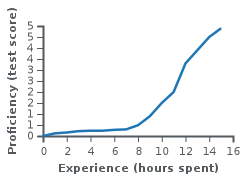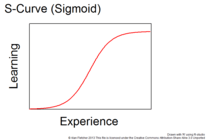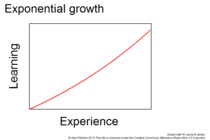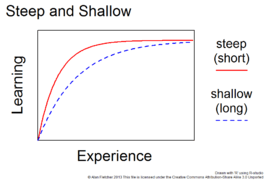Learning curve
A learning curve is a graphical representation of the relationship between how proficient someone is at a task and the amount of experience they have. Proficiency (measured on the vertical axis) usually increases with increased experience (the horizontal axis), that is to say, the more someone performs a task, the better they get at it.[1]


The common expression "a steep learning curve" means that the activity is difficult to learn and that expending a lot of effort does not increase proficiency by much, although a learning curve with a steep start would actually represent rapid progress.[2][3]
Learning curves may refer to a specific task or a body of knowledge. Hermann Ebbinghaus first described the learning curve in 1885 in the field of the psychology of learning, although the name did not come into use until 1903.[4][5] In 1936 Theodore Paul Wright described the effect of learning on production costs in the aircraft industry.[6] This form, in which unit cost is plotted against total production, is sometimes called an experience curve.
In psychology
The first person to describe the learning curve was Hermann Ebbinghaus in 1885. His tests involved memorizing series of nonsense syllables, and recording the success over a number of trials. The translation does not use the term learning curve—but he presents diagrams of learning against trial number. He also notes that the score can decrease, or even oscillate.[3][7][8]
The first known use of the term learning curve is from 1903: "Bryan and Harter (6) found in their study of the acquisition of the telegraphic language a learning curve which had the rapid rise at the beginning followed by a period of retardation, and was thus convex to the vertical axis."[5][3]
Psychologist Arthur Bills gave a more detailed description of learning curves in 1934. He also discussed the properties of different types of learning curves, such as negative acceleration, positive acceleration, plateaus, and ogive curves. (Fig 1)[9]
In economics
In 1936, Theodore Paul Wright described the effect of learning on production costs in the aircraft industry and proposed a mathematical model of the learning curve.[6]
In 1968 Bruce Henderson of the Boston Consulting Group (BCG) generalized the Unit Cost model pioneered by Wright, and specifically used a Power Law, which is sometimes called Henderson's Law.[10] He named this particular version the experience curve.[11][12] Research by BCG in the 1970s observed experience curve effects for various industries that ranged from 10 to 25 percent.[13]
The economic learning of productivity and efficiency generally follows the same kinds of experience curves and have interesting secondary effects. Efficiency and productivity improvement can be considered as whole organization or industry or economy learning processes, as well as for individuals. The general pattern is of first speeding up and then slowing down, as the practically achievable level of methodology improvement is reached. The effect of reducing local effort and resource use by learning improved methods paradoxically often has the opposite latent effect on the next larger scale system, by facilitating its expansion, or economic growth, as discussed in the Jevons paradox in the 1880s and updated in the Khazzoom-Brookes Postulate in the 1980s.
Examples and mathematical modeling
A learning curve is a plot of proxy measures for implied learning (proficiency or progression toward a limit) with experience.
- The Horizontal Axis represents experience either directly as time (clock time, or the time spent on the activity), or can be related to time (a number of trials, or the total number of units produced).
- The Vertical Axis is a measure representing learning or proficiency or other proxy for "efficiency" or "productivity". It can either be increasing (for example, the score in a test), or decreasing (the time to complete a test). (Fig 5)
For the performance of one person in a series of trials the curve can be erratic, with proficiency increasing, decreasing or leveling out in a plateau. (Fig 1)
When the results of a large number of individual trials are averaged then a smooth curve results, which can often be described with a mathematical function. (Fig 2)
 Fig 3: S-Curve or Sigmoid Function
Fig 3: S-Curve or Sigmoid Function Fig 4: Exponential growth
Fig 4: Exponential growth Fig 5: Exponential rise or fall to a limit
Fig 5: Exponential rise or fall to a limit Fig 6: Power Law
Fig 6: Power Law
Several main functions have been used:[14][15][16]
- The S-Curve or Sigmoid function is the idealized general form of all learning curves, with slowly accumulating small steps at first followed by larger steps and then successively smaller ones later, as the learning activity reaches its limit. That idealizes the normal progression from discovery of something to learn about followed to the limit of what learning about it. The other shapes of learning curves (4, 5 & 6) show segments of S-curves without their full extents.
- In this case the improvement of proficiency starts slowly, then increases rapidly, and finally levels off. (Fig 3)
- Exponential growth
- The proficiency can increase without limit, as in Exponential growth (Fig 4)
- Exponential rise or fall to a Limit
- Proficiency can exponentially approach a limit in a manner similar to that in which a capacitor charges or discharges (Exponential decay) through a resistor. (Fig 5)
- The increase in skill or retention of information may increase rapidly to its maximum rate during the initial attempts, and then gradually levels out, meaning that the subject's skill does not improve much with each later repetition, with less new knowledge gained over time.
- This is similar in appearance to an Exponential decay function, and is almost always used for a decreasing performance metric, such as cost. (Fig 6) It also has the property that if you plot the logarithm of proficiency against the logarithm of experience the result is a straight line, and it is often presented that way.
- The specific case of a plot of Unit Cost versus Total Production with a Power Law was named the experience curve: the mathematical function is sometimes called Henderson's Law.
- This form of learning curve is used extensively in industry for cost projections.[17]
In machine learning
Plots relating performance to experience are widely used in machine learning. Performance is the error rate or accuracy of the learning system, while experience may be the number of training examples used for learning or the number of iterations used in optimizing the system model parameters.[18] The machine learning curve is useful for many purposes including comparing different algorithms,[19] choosing model parameters during design,[20] adjusting optimization to improve convergence, and determining the amount of data used for training.[21]
Broader interpretations
Initially introduced in educational and behavioral psychology, the term has acquired a broader interpretation over time, and expressions such as "experience curve", "improvement curve", "cost improvement curve", "progress curve", "progress function", "startup curve", and "efficiency curve" are often used interchangeably. In economics the subject is rates of "development", as development refers to a whole system learning process with varying rates of progression. Generally speaking all learning displays incremental change over time, but describes an "S" curve which has different appearances depending on the time scale of observation. It has now also become associated with the evolutionary theory of punctuated equilibrium and other kinds of revolutionary change in complex systems generally, relating to innovation, organizational behavior and the management of group learning, among other fields.[22] These processes of rapidly emerging new form appear to take place by complex learning within the systems themselves, which when observable, display curves of changing rates that accelerate and decelerate.
General learning limits
Learning curves, also called experience curves, relate to the much broader subject of natural limits for resources and technologies in general. Such limits generally present themselves as increasing complications that slow the learning of how to do things more efficiently, like the well-known limits of perfecting any process or product or to perfecting measurements.[23] These practical experiences match the predictions of the second law of thermodynamics for the limits of waste reduction generally. Approaching limits of perfecting things to eliminate waste meets geometrically increasing effort to make progress, and provides an environmental measure of all factors seen and unseen changing the learning experience. Perfecting things becomes ever more difficult despite increasing effort despite continuing positive, if ever diminishing, results. The same kind of slowing progress due to complications in learning also appears in the limits of useful technologies and of profitable markets applying to product life cycle management and software development cycles). Remaining market segments or remaining potential efficiencies or efficiencies are found in successively less convenient forms.
Efficiency and development curves typically follow a two-phase process of first bigger steps corresponding to finding things easier, followed by smaller steps of finding things more difficult. It reflects bursts of learning following breakthroughs that make learning easier followed by meeting constraints that make learning ever harder, perhaps toward a point of cessation.
- Natural Limits One of the key studies in the area concerns diminishing returns on investments generally, either physical or financial, pointing to whole system limits for resource development or other efforts. The most studied of these may be Energy Return on Energy Invested or EROEI, discussed at length in an Encyclopedia of the Earth article and in an OilDrum article and series also referred to as Hubert curves. The energy needed to produce energy is a measure of our difficulty in learning how to make remaining energy resources useful in relation to the effort expended. Energy returns on energy invested have been in continual decline for some time, caused by natural resource limits and increasing investment. Energy is both nature's and our own principal resource for making things happen. The point of diminishing returns is when increasing investment makes the resource more expensive. As natural limits are approached, easily used sources are exhausted and ones with more complications need to be used instead. As an environmental signal persistently diminishing EROI indicates an approach of whole system limits in our ability to make things happen.
- Useful Natural Limits EROEI measures the return on invested effort as a ratio of R/I or learning progress. The inverse I/R measures learning difficulty. The simple difference is that if R approaches zero R/I will too, but I/R will approach infinity. When complications emerge to limit learning progress the limit of useful returns, uR, is approached and R-uR approaches zero. The difficulty of useful learning I/(R-uR) approaches infinity as increasingly difficult tasks make the effort unproductive. That point is approached as a vertical asymptote, at a particular point in time, that can be delayed only by unsustainable effort. It defines a point at which enough investment has been made and the task is done, usually planned to be the same as when the task is complete. For unplanned tasks it may be either foreseen or discovered by surprise. The usefulness measure, uR, is affected by the complexity of environmental responses that can only be measured when they occur unless they are foreseen.
In culture
"Steep learning curve"
The expression steep learning curve is used with opposite meanings. Most sources, including the Oxford English Dictionary, the American Heritage Dictionary of the English Language, and Merriam-Webster’s Collegiate Dictionary, define a learning curve as the rate at which skill is acquired, so a steep increase would mean a quick increment of skill.[2][24] However, the term is often used in common English with the meaning of a difficult initial learning process.[3][24]
Arguably, the common English use is due to metaphorical interpretation of the curve as a hill to climb. (A steeper hill is initially hard, while a gentle slope is less strainful, though sometimes rather tedious. Accordingly, the shape of the curve (hill) may not indicate the total amount of work required. Instead, it can be understood as a matter of preference related to ambition, personality and learning style.)
 Fig 9 : Short and long learning curves
Fig 9 : Short and long learning curves Fig 10 : Product A has lower functionality and a short learning curve. Product B has greater functionality but takes longer to learn
Fig 10 : Product A has lower functionality and a short learning curve. Product B has greater functionality but takes longer to learn
The term learning curve with meanings of easy and difficult can be described with adjectives like short and long rather than steep and shallow.[2] If two products have similar functionality then the one with a "steep" curve is probably better, because it can be learned in a shorter time. (Fig 9) On the other hand, if two products have different functionality, then one with a short curve (a short time to learn) and limited functionality may not be as good as one with a long curve (a long time to learn) and greater functionality. (Fig 10)
For example, the Windows program Notepad is extremely simple to learn, but offers little after this. At the other extreme is the UNIX terminal editor vi or Vim, which is difficult to learn, but offers a wide array of features after the user has learned how to use it.[25]
"On a steep learning curve"
Ben Zimmer discusses the use of the term "on a steep learning curve" in Downton Abbey, a television series set in the early 20th century, concentrating mainly on whether use of the term is an anachronism. "Matthew Crawley, the presumptive heir of Downton Abbey and now the co-owner of the estate, says, 'I've been on a steep learning curve since arriving at Downton.' By this he means that he's had a difficult time learning the ways of Downton. Unfortunately, people didn't start talking that way until the 1970s."[3][26][27]
Zimmer also comments that the popular use of steep as difficult is a reversal of the technical meaning. He identifies the first use of steep learning curve as 1973, and the arduous interpretation as 1978.
Difficulty curves in video games
The idea of learning curves is often translated into video game gameplay as a "difficulty curve", which described how hard the game may get as the player progresses through the game and requiring the player to either become more proficient with the game, gain better understanding of the game's mechanics, and/or spend time "grinding" to improve their characters. Establishing the right difficulty curve is part of achieving the game balance within a title. As with learning curves in educational settings, difficulty curves can have multitudes of shapes, and games may frequently provide various levels of difficulty that change the shape of this curve relative to its default to make the game harder or easier.[28][29] Optimally the difficulty of a video game increases in correspondence with players ability. Games must neither be too challenging nor too uncomplicated nor too fortuitous.[30] The players will continue playing as long as a game is perceived to be winnable, though it may not literally be the case. It is therefore called the illusion of winnability. What generates an illusion of winnability is defined by, in order of decreasing importance, internal value (a sense of regard by the game gained with the ability of players to find their own way of accomplishing goals) driven by conflict (Gives players goals meaning. It is provided by players lack of ability or knowledge which can either be literal antagonism or generated by story driven suspense in the form of world building) and different game terms punishing and rewarding players by means of, for instance, having limited resources. Players must imagine the vibrant world wherein their games takes place.[31] Hideo Kojima states that "If the player isn't tricked into believing that the world is real, then there's no point in making the game."[32]
See also
- Experience curve effects
- Learning
- Learning speed
- Labor productivity
- Learning-by-doing
- Population growth
- Trial and error
References
- Compare: "Learning Curve". Business Dictionary. Retrieved 8 December 2018.
Graphical representation of the common sense principle that more one does something the better one gets at it. Learning curve shows the rate of improvement in performing a task as a function of time, or the rate of change in average cost (in hours or dollars) as a function of cumulative output.
- "Laparoscopic Colon Resection Early in the Learning Curve", Ann. Surg. 2006 June; 243(6): 730–737, see the "Discussions" section, Dr. Smith's remark about the usage of the term "steep learning curve": "First, semantics. A steep learning curve is one where you gain proficiency over a short number of trials. That means the curve is steep. I think semantically we are really talking about a prolonged or long learning curve. I know it is a subtle distinction, but I can't miss the opportunity to make that point."
- http://www.visualthesaurus.com/cm/wordroutes/a-steep-learning-curve-for-downton-abbey/ Ben Zimmer, February 8, 2013
- https://books.google.com/books?id=oRSMDF6y3l8C&printsec=frontcover Page 42, Fig 2
- https://books.google.com/books?id=ikEMAAAAIAAJ&q=%22learning+curve%22#v=snippet&q=%22learning%20curve%22&f=false The American Journal of Psychology, Volume 14 1903 By Granville Stanley Hall, Edward Bradford Titchene
- Wright, T.P., "Factors Affecting the Cost of Airplanes", Journal of Aeronautical Sciences, 3(4) (1936): 122–128. Accessed at
- "Classics in the History of Psychology -- Introduction to Ebbinghaus (1885/1913) by R. H. Wozniak". psychclassics.yorku.ca.
- https://books.google.com/books?id=oRSMDF6y3l8C&printsec=frontcover page 42, Fig 2
- Bills, A.G. (1934). General experimental psychology. Longmans Psychology Series. (pp. 192-215). New York, NY: Longmans, Green and Co.
- "What is Henderson's Law?". Henderson's Law. Retrieved 2020-06-02.
- https://www.bcgperspectives.com/content/Classics/strategy_the_experience_curve/ BCJ 1968
- Grant, Robert M. (2004), Contemporary strategy analysis, U.S., UK, Australia, Germany: Blackwell publishing, ISBN 1-4051-1999-3
- Hax, Arnoldo C.; Majluf, Nicolas S. (October 1982), "Competitive cost dynamics: the experience curve", Interfaces, 12 (5): 50–61, doi:10.1287/inte.12.5.50.
- http://repository.cmu.edu/cgi/viewcontent.cgi?article=3420&context=compsci Mechanisms of skill acquisition and the law of practice Newell 1980
- Ritter, F. E., & Schooler, L. J. The learning curve. In International Encyclopedia of the Social and Behavioral Sciences (2002), 8602-8605. Amsterdam: Pergamon
- http://www.bgu.ac.il/~akarniel/pub/LeibowitzetalJMP2010.pdf
- "Archived copy" (PDF). Archived from the original (PDF) on 2013-07-18. Retrieved 2013-03-17.CS1 maint: archived copy as title (link) Department of Defense Manual Number 5000.2-M, mandates the use of learning curves for costing of defense programs (variable costs of production)
- Sammut, Claude; Webb, Geoffrey I. (Eds.) (2011-03-28). Encyclopedia of Machine Learning (1st ed.). Springer. p. 578. ISBN 978-0-387-30768-8.CS1 maint: extra text: authors list (link)
- Madhavan, P.G. (1997). "A New Recurrent Neural Network Learning Algorithm for Time Series Prediction" (PDF). Journal of Intelligent Systems. p. 113 Fig. 3.
- "Machine Learning 102: Practical Advice". Tutorial: Machine Learning for Astronomy with Scikit-learn.
- Meek, Christopher; Thiesson, Bo; Heckerman, David (Summer 2002). "The Learning-Curve Sampling Method Applied to Model-Based Clustering". Journal of Machine Learning Research. 2 (3): 397.
- Connie JG Gersick 1991 "Revolutionary Change Theories: A Multilevel Exploration of the Punctuated Equilibrium Paradigm" The Academy of Management Review, Vol. 16, No. 1 pp. 10-36 1
- Petley, Brian W. (1988). "Towards the Limits of Precision and Accuracy in Measurement". Physics in a Technological World (88): 291. Bibcode:1988ptw..conf..291P.
- "Steep learning curves". 2009-07-16.
- http://unix.rulez.org/~calver/pictures/curves.jpg Apparently from http://blogs.msdn.com/b/steverowe/archive/2004/11/17/code-editor-learning-curves.aspx Code Editor Learning Curves SteveRowe 17 Nov 2004 7:59 PM
- http://languagelog.ldc.upenn.edu/nll/?p=3767 "Downton Abbey" anachronisms: beyond nitpickery, Ben Zimmer, February 13, 2012
- http://languagelog.ldc.upenn.edu/nll/?p=3767 Comment by J Oliver : Season Three, episode 5
- Larsen, Jimmy Marcus (May 24, 2010). "Difficulty Curves". Gamasutra. Retrieved February 3, 2020.
- Aponte, Maria-Virginia; Levieux, Guillaume; Natkin, Stéphane (2009). "Scaling the Level of Difficulty in Single Player Video Games" (PDF). In Natkin, S.; Dupire, J. (eds.). Lecture Notes in Computer Science. International Conference on Entertainment Computing 2009. 5709. Berlin: Springer. doi:10.1007/978-3-642-04052-8_3. Retrieved February 3, 2020.
- Ruggill, Judd Ethan; McAllister, Ken S. (11 May 2011). "Work". Gaming Matters: Art, Science, Magic, and the Computer Game Medium. University of Alabama Press. p. 89. ISBN 978-0-8173-1737-9.
- Van Eck, Richard (31 May 2010). "Feedforward as an Essential Active Principle". Gaming and Cognition: Theories and Practice from the Learning Sciences: Theories and Practice from the Learning Sciences. IGI Global. pp. 112–115. ISBN 978-1-61520-718-3.
- Holmes, Dylan (2012). "The Rise of Cutscenes". A Mind Forever Voyaging: A History of Storytelling in Video Games. Dylan Holmes. p. 83. ISBN 978-1-4800-0575-4.